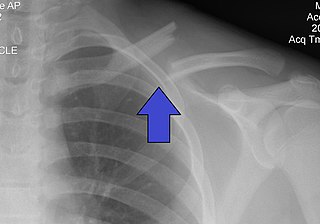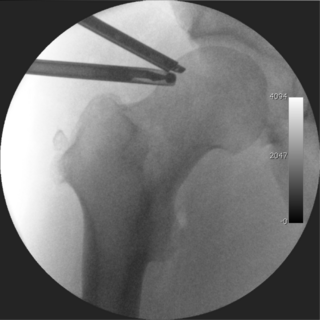Related Research Articles

Arthroscopy is a minimally invasive surgical procedure on a joint in which an examination and sometimes treatment of damage is performed using an arthroscope, an endoscope that is inserted into the joint through a small incision. Arthroscopic procedures can be performed during ACL reconstruction.

Shoulder problems including pain, are one of the more common reasons for physician visits for musculoskeletal symptoms. The shoulder is the most movable joint in the body. However, it is an unstable joint because of the range of motion allowed. This instability increases the likelihood of joint injury, often leading to a degenerative process in which tissues break down and no longer function well.
Mumford may refer to:

Orthopedic surgery or orthopedics, is the branch of surgery concerned with conditions involving the musculoskeletal system. Orthopedic surgeons use both surgical and nonsurgical means to treat musculoskeletal trauma, spine diseases, sports injuries, degenerative diseases, infections, tumors, and congenital disorders.

A bone fracture is a medical condition in which there is a partial or complete break in the continuity of any bone in the body. In more severe cases, the bone may be broken into several fragments, known as a comminuted fracture. A bone fracture may be the result of high force impact or stress, or a minimal trauma injury as a result of certain medical conditions that weaken the bones, such as osteoporosis, osteopenia, bone cancer, or osteogenesis imperfecta, where the fracture is then properly termed a pathologic fracture.

A clavicle fracture, also known as a broken collarbone, is a bone fracture of the clavicle. Symptoms typically include pain at the site of the break and a decreased ability to move the affected arm. Complications can include a collection of air in the pleural space surrounding the lung (pneumothorax), injury to the nerves or blood vessels in the area, and an unpleasant appearance.

The supraspinatus is a relatively small muscle of the upper back that runs from the supraspinous fossa superior portion of the scapula to the greater tubercle of the humerus. It is one of the four rotator cuff muscles and also abducts the arm at the shoulder. The spine of the scapula separates the supraspinatus muscle from the infraspinatus muscle, which originates below the spine.

The triangular fibrocartilage complex (TFCC) is formed by the triangular fibrocartilage discus (TFC), the radioulnar ligaments (RULs) and the ulnocarpal ligaments (UCLs).

A separated shoulder, also known as acromioclavicular joint injury, is a common injury to the acromioclavicular joint. The AC joint is located at the outer end of the clavicle where it attaches to the acromion of the scapula. Symptoms include non-radiating pain which may make it difficult to move the shoulder. The presence of swelling or bruising and a deformity in the shoulder is also common depending on how severe the dislocation is.
Shoulder surgery is a means of treating injured shoulders. Many surgeries have been developed to repair the muscles, connective tissue, or damaged joints that can arise from traumatic or overuse injuries to the shoulder.

The Weaver–Dunn procedure is a generally successful type of surgery involved in the treatment of severe separated shoulders developed by James K. Weaver, M.D., Albuquerque, New Mexico, and Harold K. Dunn, M.D., Salt Lake City, Utah, in the early 1970s.

A scaphoid fracture is a break of the scaphoid bone in the wrist. Symptoms generally includes pain at the base of the thumb which is worse with use of the hand. The anatomic snuffbox is generally tender and swelling may occur. Complications may include nonunion of the fracture, avascular necrosis of the proximal part of the bone, and arthritis.
Extravasation is the leakage of a fluid out of its container into the surrounding area, especially blood or blood cells from vessels. In the case of inflammation, it refers to the movement of white blood cells from the capillaries to the tissues surrounding them. In the case of malignant cancer metastasis it refers to cancer cells exiting the capillaries and entering organs. It is frequently used in medical contexts, either referring to urine, or to blood.

Shoulder impingement syndrome is a syndrome involving tendonitis of the rotator cuff muscles as they pass through the subacromial space, the passage beneath the acromion. It is particularly associated with tendonitis of the supraspinatus muscle. This can result in pain, weakness, and loss of movement at the shoulder.
Sham surgery is a faked surgical intervention that omits the step thought to be therapeutically necessary.

Hip arthroscopy refers to the viewing of the interior of the acetabulofemoral (hip) joint through an arthroscope and the treatment of hip pathology through a minimally invasive approach. This technique is sometimes used to help in the treatment of various joint disorders and has gained popularity because of the small incisions used and shorter recovery times when compared with conventional surgical techniques. Hip arthroscopy was not feasible until recently, new technology in both the tools used and the ability to distract the hip joint has led to a recent surge in the ability to do hip arthroscopy and the popularity of it.
Osteoplasty is the branch of surgery concerned with bone repair or bone grafting. It is the surgical alteration or reshaping of bone. It may be used to relieve pain associated with metastatic bone disease. Percutaneous osteoplasty involves the use of bone cement to reduce pain and improve mobility. Resection osteoplasty is used in joint preserving surgery on the hip and thigh bones.

Wrist arthroscopy can be used to look inside the joint of the wrist. It is a minimally invasive technique which can be utilized for diagnostic purposes as well as for therapeutic interventions. Wrist arthroscopy has been used for diagnostic purposes since it was first introduced in 1979. However, it only became accepted as diagnostic tool around the mid-1980s. At that time, arthroscopy of the wrist was an innovative technique to determine whether a problem could be found in the wrist. A few years later, wrist arthroscopy could also be used as a therapeutic tool.

Labral reconstruction is a type of hip arthroscopy in which the patient's native labrum is partially or completely removed and reconstructed using either autograft or allograft tissue. Originally described in 2009 using the ligamentum teres capitis, arthroscopic labral reconstruction using a variety of graft tissue has demonstrated promising short and mid-term clinical outcomes. Most importantly, labral reconstruction has demonstrated utility when the patient's native labral tissue is far too damaged for debridement or repair.

Dr. Eugene Bishop or E.B. Mumford (1879-1961) was an American orthopedic surgeon, founder, and president of the American Academy of Orthopedic Surgeons. Mumford was known for his pioneering research of arthritis, joint stiffness, and creation of distal clavical excision or acromioplasty commonly known as The Mumford Procedure.
References
- 1 2 Lervick, Gregory N. (2005). "Direct Arthroscopic Distal Clavicle Resection". Iowa Orthopaedic Journal. 25: 149–56. PMC 1888780 . PMID 16089089.
- ↑ Winslow Alford, MD and Bernard Bach MD (2004). "Open distal clavicle resection" (PDF). Operative Techniques in Sports Medicine. 12: 9–17. doi:10.1053/j.otsm.2004.04.009 – via Elsevier.
- ↑ Brand, Richard A. (January 2008). "Early Active Motion in Joint Pain and Stiffness". Clinical Orthopaedics and Related Research. 466 (1): 113–116. doi:10.1007/s11999-007-0022-5. ISSN 0009-921X. PMC 2505291 . PMID 18196380.